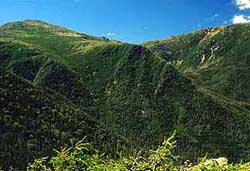| AQRV Type: VISIBILITY |
| Sensitive Receptor |
Sensitive Receptor Indicator |
Thresholds |
| Natural Visibilty |
|
For sources generally further than 50 km from a Class I area, the visibility threshold for concern is not exceeded if the 98th %ile change in light extinction is <5% for each year modeled, when compared to the annual average natural condition value for that Class I area. |
| Plume Blight |
Absolute Contrast |
Higher level near-field screening and refined analysis: no further analysis will likely be requested if a new or modified source can show that impacts from a new or modified source will stay with the threshold of DeltaE <1.0 and |C| <0.02 modeled against natural conditions. |
| Plume Blight |
Absolute Contrast |
For near field sources (within 50 km of a Class I area), no additional analysis will be requested If screening analysis of a new or modified source can demonstrate that its emissions will not cause a plume with hourly estimates of DeltaE (color difference index) greater than or equal to 2.0 or the absolute value of the contrast greater than or equal to 0.05 when modeled against natural conditions. |
| Plume Blight |
Color Difference Index |
Plume blight near-field refined analysis: no further analysis will likely be requested if a new or modified source can show that impacts from a new or modified source will stay with the threshold of DeltaE <1.0 and |C| <0.02 when modeled against natural conditions. |
| Plume Blight |
Color Difference Index |
For near field sources (within 50 km of a Class I area), no additional analysis will be requested If screening analysis of a new or modified source can demonstrate that its emissions will not cause a plume with hourly estimates of DeltaE (color difference index) greater than or equal to 2.0 or the absolute value of the contrast greater than or equal to 0.05 when modeled against natural conditions. |
|
| AQRV Type: WATER |
| Sensitive Receptor |
Sensitive Receptor Indicator |
Thresholds |
| Aquatic Organisms |
Chemistry |
Total sulfur plus 20% of nitrogen deposition at levels exceeding 16 kg/ha-yr may cause ANC loss that would impact aquatic organisms. Levels below 7 kg/ha-yr are not expected to significantly impact aquatic organisms. |
| Aquatic Organisms |
Chemistry |
Sulfur deposition may significantly impact aquatic organisms at levels above 14 kg/ha/yr. Levels below 6 kg/ha-yr are not expected to significantly impact aquatic organisms. |
| Perennial Lakes and Streams |
Chronic Acid Neutralizing Capacity |
To maintain healthy biological functioning in perennial lakes and streams, the chronic acid neutralizing capacity must be >= 25 ueq/l. ANC's below 10 ueq/L (the red line) are expected to cause adverse effects. |
| Perennial Lakes and Streams |
Episodic Acid Neutralizing Capacity |
To maintain healthy biological functioning in perennial lakes and streams, the episodic acid neutralizing capacity must be >= 0 ueq/l. |


![[graphic] Forest Service logo](../../wo-resources/images/wo-usda.jpg)

